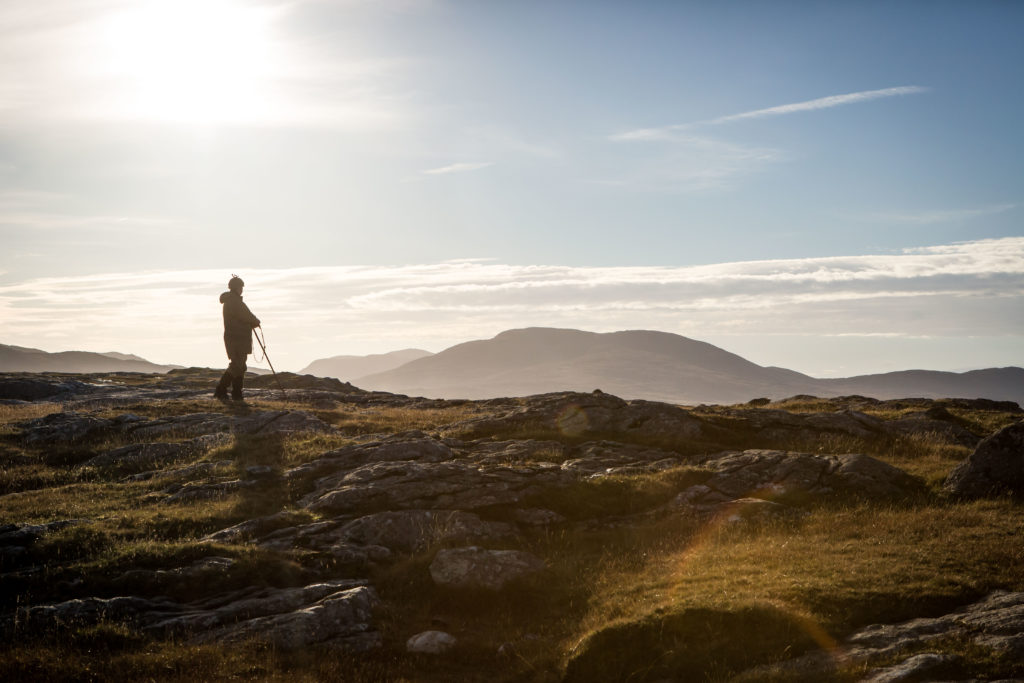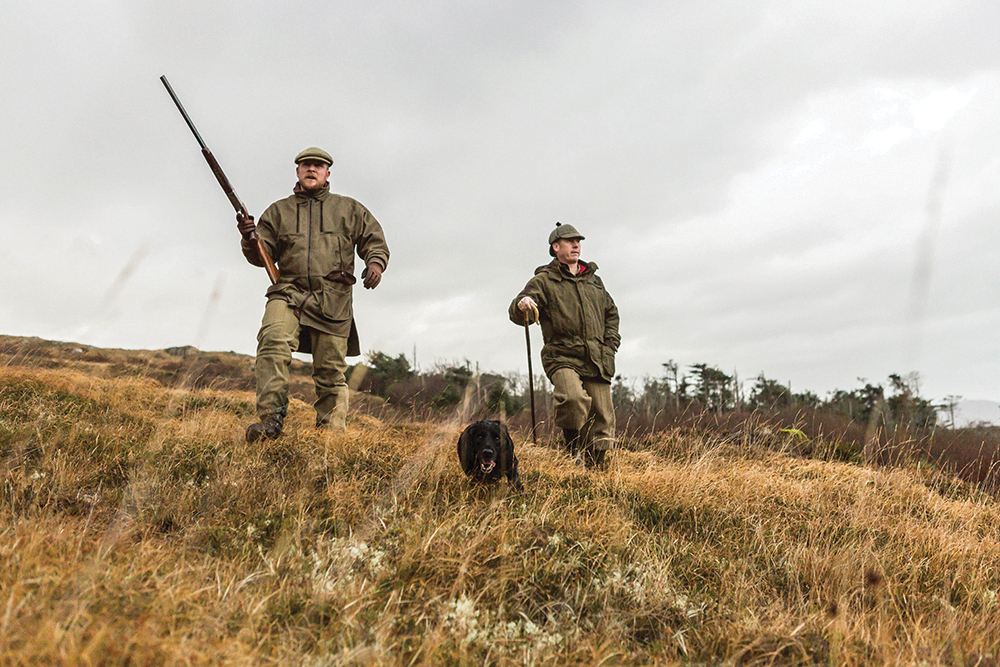Western Isles Woodcock

Time seems to have forgotten Scotland’s Outer Hebrides. To some, these islands are desolate, barren, and bleak—but to field-sports enthusiasts, the Western Isles are without question one of the most stunning places on Earth. Many do not realize that the Western Isles boast soft, white sandy beaches and aquamarine waters comparable to tropical islands. Walked-up woodcock shooting on Harris in the Outer Hebrides was one of my favorite experiences of the past year.
Harris is in fact part of one island, joined with Lewis to the north and divided into North and South Harris by a narrow isthmus. Those living full time on the island tend to be orthodox Presbyterian, which means virtually all commercial activity ceases on Sundays, and a large proportion of the population attends church every week. Inhabitants do not drive their cars, draw their curtains, or hang out their wash on this sacred day. The slow pace of life on Harris, paired with the peace and quiet, make a visit soul cleansing and restorative. In fact, according to recent data from the United Kingdom’s Office for National Statistics, people who live in this isolated corner of Scotland report the highest levels of life satisfaction, self-worth, and happiness across the whole of Great Britain.

My wife Selena and I stayed at Borve Lodge Estate, a 7,500-acre playground located on the west coast overlooking the Atlantic. Originally built as a sporting lodge around 1868 by Charles Adolphus Murray, 7th Earl of Dunmore, at that time Borve Lodge Estate was an aristocratic destination for shooting and fishing. The word “borve” means fortress, and the ruins of a Bronze Age fortress or duin are within a few hundred yards of Borve. We had the entire place to ourselves.
A member of the Scottish Country Sports Tourism Group, Borve Lodge Estate has marbled washrooms, million-thread- count cotton bed linens, and breathtaking views across the Sound of Taransay. This is a five-star luxury accommodation, located where you would not expect it to be. With space for up to 16 people, the lodge has a private chef and housekeeper, while the estate campus has four self-catering cottages—two traditional island dwellings and two unbelievable, highly modern, architecturally inspired one-bedroom spaces—which take the experience to a level previously unknown on this remote island.
Getting to Harris from London is not difficult. There are two options: fly into Stornaway; or drive 680 miles, almost the full length of the UK, up through Skye and catch a ferry. We opted for the second way, and from London that took around two long days but the scenery out of the car window was spectacular. Road trips provide unrivaled thinking time and are a great way of shaking off work stresses before you arrive at your destination.


For our day of walked-up woodcock shooting, Borve Lodge Estate Manager Steve Woodhall and I had a corner of the island all to ourselves. After working for three years at Griffith Island, a private sport shooting and hunting club in Canada, Steve returned to the Hebrides last year to help Borve get established as a top-drawer sporting destination. A seasoned gamekeeper, Steve relishes the challenges at Borve Lodge Estate. “After the estate was bought by Adam and Cathra Kelliher in 2008, they wanted to inject new life into the area. Not only do we now offer woodcock and snipe shooting, but also red deer stalking, plus salmon and trout fishing on the Laxdale System and Loch Fincastle,” he told me.
The weather during our stay was phenomenal—complete sunshine—but Steve said this about the climate on the island: “The old adage runs, if you don’t like the weather in Harris, wait five minutes. In one day, particularly in the transition months as autumn moves into winter, you can experience blinding blue skies, a squall, and a hailstorm. The Atlantic provides dramatic and intense weather patterns, so you need to be well prepared to get the most from this unique environment.”
We were joined on the hunt by my veteran cocker, Archie. The plan was to work him close and attempt to bag supper using a Zoli shotgun teamed with #6 cartridges. “The island is teeming with woodcock so only take the sporting birds,” cautioned Steve, meaning to shoot only the flushing birds, as we prepared to start quietly making our way through the marshy grasslands. In addition to the resident population of woodcock, a wintering population migrates to the UK that could number as many as 1.5 million birds in some years. We certainly found woodcock plentiful on Harris. Within seconds of taking our first strides through the boggy grass, we flushed our first bird—but I saw it too late. We continued walking in search of these diminutive wading birds.
My cocker Archie knew his job—he quartered the cover in front of us, and turned to the whistle with each pip, working steadily to ensure every inch was sniffed out and rarely ranging more than 15 feet out. Then, in a flash, a woodcock lifted. We watched it tumble at my shot. To succeed at this kind of shooting, you need lightning-fast reactions. Unlike standing at peg on a pheasant shoot, there are no beaters or flaggers funneling the quarry over you in predictable waves. If you miss, that could be your only opportunity of the day. This is the sport of proper hunter-gatherers with no frills. It’s just you, the shotgun, the hunting dog, and wild birds.

Throughout the afternoon, my heart was pumping through my chest and each of my senses was amplified. My next chance came when, out of the corner of my eye, I spied another two woodcock trying to make a getaway. Steve let out an animated cry and pointed to the racing birds. Without hesitation, I connected the gun’s muzzle to the first bird’s flight line, but I missed the second. It was hugely satisfying to watch the spent bird corkscrew earthward. Another one for the pot—almost enough for our supper. Trying to ignore the distracting far-reaching views across to the neighboring island of Taransay, I focused on scanning the grass for the whir of wings and stared into the darkening sky. The Zoli shotgun had proved itself as the perfect tool for the job. Lightweight and easy to swing, the Italian-made 12-bore connected to my cheek and shoulder with smoothness and accuracy.
To my mind, there’s something a bit old-fashioned about woodcock shooting. Reminiscent of days gone by, the method of hunting these wily gamebirds has not changed for centuries. It tests your sporting prowess and exposes your flaws on full display. Instinctual snap shooting tests not only your ability to connect with a target but also to identify quarry correctly and assess safety—all in a wingbeat.
If you enjoy the challenge of woodcock, returning to driven shooting can seem a little pedestrian by comparison. Some of these birds have survived migrating all the way from Siberia, so they are well equipped at dodging predators wanting to stop them. The cartridge-to-bird ratio is always very high indeed. If it was easy and straightforward, I would not be so drawn to the sport. The same as salmon fishing with flies, shooting woodcock is far from predictable—there’s every chance you’ll go home empty-handed and be forced to swing by the local pub for supper instead of enjoying a home-cooked meal featuring nature’s bounty.
That night, we took our coastal harvest back to Borve, where the chef prepared the birds in the traditional way. Each bird was roasted rare, trussed with its own beak, and accompanied by its entrails on fried bread. Perhaps not for the weak-stomached, but a real delicacy if, like me, you are a lover of game.
The next morning, we awoke in our enormous super-king bed to the soft sound of the sea outside our window. Emerging downstairs for breakfast was delayed somewhat due to the complimentary spotting scope and tripod set up in our bedroom, which meant we could spy on wildlife along the lodge’s private beach. Somehow I knew the long drive home wasn’t going to be half as enjoyable as it was coming from London. A return trip to Borve is already in the cards.
























